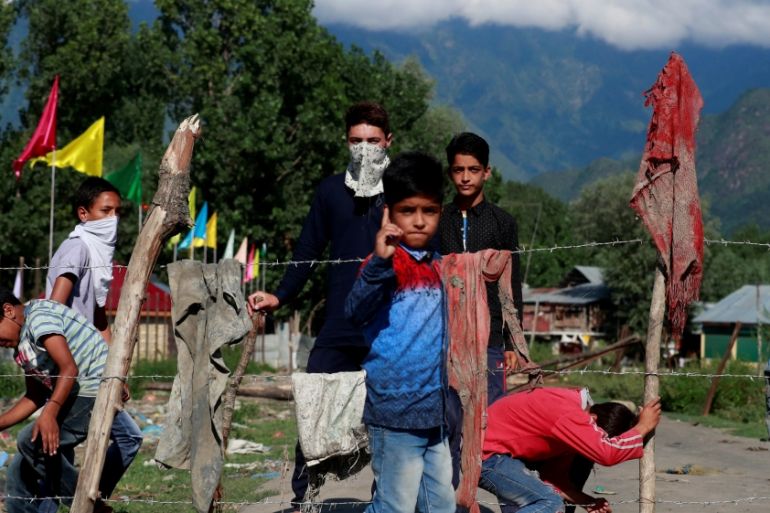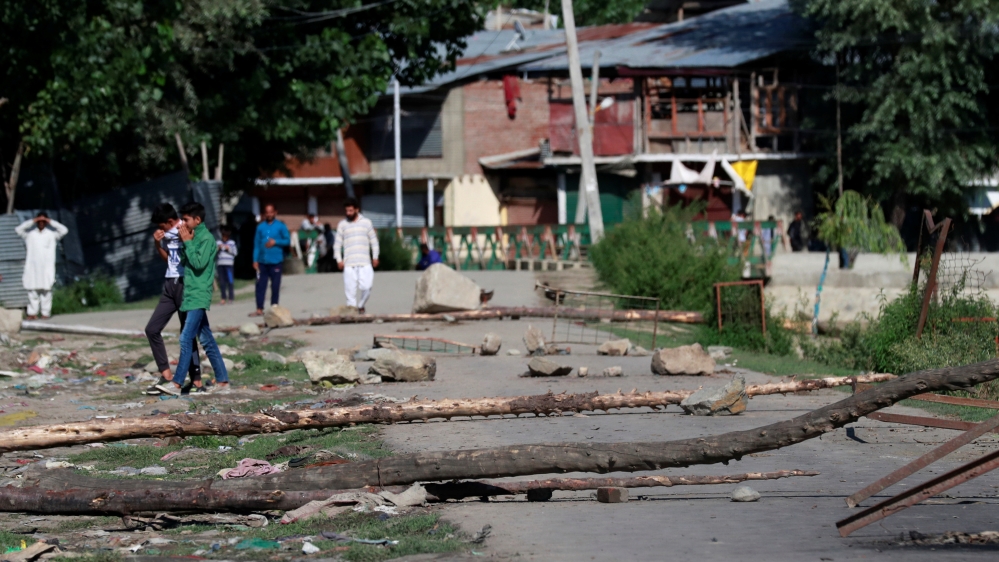‘Fighting back’: Kashmir enclave blocks entry of Indian troops
Residents in Soura neighbourhood of Srinagar, Indian-administered Kashmir, plant barricades to keep security forces out.

For more than a week, the young men of Soura, a densely-populated enclave in Indian-administered Kashmir‘s main city of Srinagar, have been taking turns to maintain a round-the-clock vigil at the entry points to their neighbourhood.
Each of the dozen or so entrances have been blocked with makeshift barricades of bricks, corrugated metal sheets, wooden slabs and felled tree trunks. Groups of youths armed with stones congregate behind the biggest obstacles.
Their aim: to keep Indian security forces, and particularly the paramilitary police, out of the area.
“We have no voice. We are exploding from within,” said Ejaz, 25, who, like many other residents in Soura interviewed by Reuters news agency, gave only one name, saying he feared arrest.
“If the world won’t listen to us too, then what should we do? Pick up guns?”
Soura, home to about 15,000 people, is becoming the epicentre of resistance to the government’s removal on August 5 of the partial autonomy enjoyed by Jammu and Kashmir, the country’s only Muslim-majority state.
The enclave, which has effectively become a no-go zone for Indian security forces, is now a barometer of the ability of Prime Minister Narendra Modi‘s Hindu nationalist government to impose its will in Kashmir after its dramatic move.
The change, the government said, was necessary to integrate Kashmir fully into India, tackle corruption and nepotism, and speed up its development, which Modi says is the key to securing lasting peace and defeating “terrorism”.

In Soura, it is hard to find anyone who supports Modi’s move. Many of the more than two dozen residents interviewed by Reuters over the past week referred to Modi as “zaalim”, an Urdu word meaning “tyrant”.
The constitutional change will allow non-residents to buy property in Jammu and Kashmir and apply for jobs in local government.
Some Muslims in Kashmir say they fear that India’s dominant Hindu population will overrun the lush state at the foot of the Himalayas and that Kashmiris’ identity, culture and religion will be diluted and repressed.
“We feel like we are guarding the LoC here,” said Ejaz, referring to the Line of Control, the highly militarised de facto border between the Indian and Pakistan-administered parts of Kashmir.
For decades, Kashmir has been a source of friction between nuclear-armed India and Pakistan. Both nations claim the region in full and have fought two wars over the territory since 1947.
Residents in Soura say dozens of people have been injured in clashes with the paramilitary police over the past week. It is unclear how many have been detained.
A spokesman for the Jammu and Kashmir government declined to answer questions from Reuters.
The Indian government’s Home Ministry did not return calls and emails seeking comment.
Focal point of resistance
In Srinagar, the government has banned gatherings of more than four people, set up scores of roadblocks to prevent movement, and reportedly detained thousands of people, including former chief ministers of the state, community leaders, and activists.
Internet and cellphone services have been out for more than two weeks throughout the city and the rest of the Kashmir valley, making it difficult for opponents of the government’s decision to organise protests.
Landline phone service has begun to return to the region but not to Soura, which is best-known for a Muslim shrine and a well-regarded medical college.
|
|
Residents have found other ways to organise.
When they spot security forces trying to enter the area, residents say they rush to a mosque and sound the alarm by playing a devotional song calling for people to “stand against illegal occupation”, or by issuing an alert over the loudspeaker.
Piles of bricks and stones, ready to use against Indian troops, sit at the intersections of the narrow lanes that make up Soura, a largely lower middle class area bounded to the west by a lake and marshy wetlands.
At one barricade, concertina wire had been strung across the road. The young men patrolling the barrier said the wire had been stolen from Indian security forces.
A protest on August 9, when people took to the streets after Friday prayers, marked Soura as the focal point of resistance to the Indian government’s decision. As residents from surrounding neighbourhoods joined the demonstration, the crowd swelled to at least 10,000, according to local police sources.
More than a dozen residents told Reuters that around 150 to 200 security personnel in riot gear attempted to enter Soura after the protests, resulting in clashes with residents that went on late into the night, as police fired tear gas and metal pellets.
The Indian government initially denied there had been a protest, saying there had been no gathering in Soura involving more than 20 people.
It later said there had been a demonstration of 1,000 to 1,500 people, after TV footage of the crowd was broadcast by the BBC and Al Jazeera.
‘Fighting back’
Since then, Soura has been the scene of smaller demonstrations and daily running battles with the security forces, according to people living in the neighbourhood.
The security forces have made several attempts to enter Soura, according to residents, with the apparent goal of sealing off a large area of open ground next to the Jinab Sahib shrine that has become an assembly point for protesters.
India’s paramilitary police say they are determined to regain control of the area.
“We have been trying to enter, but there is a lot of resistance in that neighbourhood,” said an Indian paramilitary police official in Srinagar who spoke on condition of anonymity.
Another senior security official told Reuters on condition of anonymity that “some of the youth of the area are highly radicalised” and it is “a hotbed of militancy”.
But the residents said they will continue to resist the entry of the security forces.
“Every day they are trying to attack us here, but we are fighting back,” said Owais, in his early twenties. “We feel like we are trapped.”